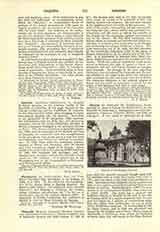

Caracas (or SANTIAGO DE VENEZUELA), ARCH-Diocese of (SANCTI JACOBI DE BENEZUELA), in the Republic of Venezuela, a metropolitan see with Barquisimeto, Calabozo, Guayana, Merida, and Zulia as suffragans. It was made an episcopal see in 1530, soon after the Spanish conquest, though until 1637 the residence was at Coro, was vacant from 1721 to 1727, and was raised to the rank of an archdiocese in 1803. Archbishop Juan Bautista Castro, appointed in 1904, was the eighth metropolitan and the thirty-fourth Bishop of Caracas. Battandier gives (1907) the population of the archdiocese as 425,640; that of the city is (1904) 60,000. The latter has a pleasant and healthful climate, is situated at the foot of the Silla de Caracas (4017 ft.), and is connected with the seaport La Guaira by a railway of twenty-three miles. The city suffers from earthquakes, in one of which (1812) 12,000 lives were lost. It was founded in 1567 by Diego Losada, and in 1595 was plundered and burned by the English under Drake; Bishop Juan de Manzanillo, a Dominican, soon rebuilt the Cathedral of Santa Anna that still stands in the Plaza Bolivar.
There are 102 priests and 110 churches and chapels. The University of Caracas, founded in 1822, has faculties of political, medical, mathematical, and ecclesiastical sciences; the chairs of the latter faculty are in the metropolitan seminary.
The Church has suffered in Caracas more perhaps than in any other of the South American Republics. The university, therefore, the seminary, the convents that once flourished in that beautiful city, have gone through many hardships, and it is difficult to give an accurate account of their present condition. The population on the whole can still be called Catholic, while the recent International Eucharistic Congress celebrated in Caracas shows a revival in the Venezuelan Church.
J. MONTES DE OCA Y OBREGON

